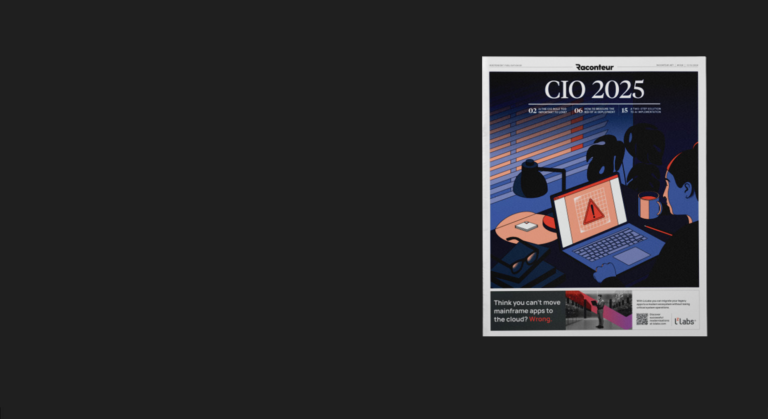Every application modernisation effort, regardless of the platform, presents significant challenges. This is even more pronounced when dealing with existing applications on a mainframe. Legacy applications are designed to support current business needs. However, new challenges continually emerge on the horizon: new requirements must be addressed, which can only be accommodated to a limited extent by existing applications that have evolved over decades or require application behaviours that have not yet been anticipated.
Can you keep pace with agile competition?
Your market is intensifying the pressure: Competitors increasingly rely on applications that enable them to leverage data more effectively. Or a new entrant is making strides in the market with a digital-centric approach. Established companies are constantly confronted with the question of maintaining competitiveness over the long term. Of course, you can’t simply discard your valuable data and established processes to embrace the complexities and risks of a complete overhaul. After all, existing data and applications represent precious assets, even if these applications are increasingly reaching their limitations.
Overcoming these limitations is the driving force behind modernisation. This is not a one-off task but an ongoing, recurrent process that can and should be approached in various ways.
The Seven Rs of Application Modernisation
What modernisation options are available for existing applications when the current IT platform is too constraining? The market research company Gartner initially defined the well-known five Rs for this purpose, but now it’s referred to as the 7R’s:
The application software is deployed in a different hardware environment (typically x86-based) or in the cloud. The applications operate as they did on the original mainframe. Modern infrastructure and cost savings provide a foundation for further modernisation and innovation.
Significant changes are made to the application’s architecture, such as breaking it into smaller, more modular components. This approach can enhance application flexibility and ease of maintenance.
The application software is freed from known vulnerabilities while retaining its existing functionality and code structure. The result is more readable code with reduced complexity.
Critical applications are partially or entirely rewritten to make them compatible with a modern system platform or the cloud.
The application software is rebuilt from the ground up to enable migration to the cloud.
In this scenario, readily available standard software typically replaces the existing application. While this eliminates the maintenance burden due to diminishing internal expertise, new dependencies may arise due to software providers’ licensing regulations.
The legacy application is entirely phased out because other applications have taken over its business processes.
These options can also be combined based on your needs and company-specific priorities. There is no one-size-fits-all approach, as each application must be individually considered within your business strategy.
What’s new today becomes obsolete tomorrow.
Application modernisation is a challenge every organisation faces, yet it receives relatively little attention from academia and research. It poses a significant challenge for every IT department, regardless of its scope, quality, or the innovation platform it employs. Even in the age of ubiquitous digitisation, this fundamental fact remains unchanged. Only the technological cycles and available options have evolved significantly in recent years, including the combination of rehosting and refactoring, among others.
Application modernisation entails change, and IT departments naturally approach the risks associated with IT changes cautiously. As much as companies want to enhance their applications, experience shows that necessary changes can lead to disruptions or even failures. Of course, no company desires such outcomes. Nonetheless, change is essential and unavoidable: “Standing still is a step backwards.” In other words, change is inevitable, and modernisation is a necessity.
Many Paths Lead to the Modernisation Goal
Is there a single approach or solution that addresses this fundamental challenge? The resounding answer is no, we must disappoint you. No single application, architecture, technology, or methodology can tackle this task in isolation. There is no one-size-fits-all solution. The right modernisation strategy for your organisation depends on your specific requirements, which may evolve over time. To quote Grace Murray Hopper, the pioneer of Cobol: “A ship in port is safe, but that’s not what ships are built for.” Therefore, we must adapt to change and adjust modernisation measures accordingly. Moreover, the chosen innovation platform can also change over time, necessitating adjustments to the modernisation plan.
At LzLabs, we believe in the substantial value of your legacy applications and data. Additionally, we advocate changing only what truly needs change. We endorse an iterative, incremental, and interoperable approach. We do not believe in a one-size-fits-all solution; our solution is no exception. As the renowned French mathematician and philosopher René Descartes, once said, “Those who walk slowly but consistently on the right path can go much farther than those who run and veer off course.” It is crucial to embrace change and prepare for ongoing modernisation measures. In principle, advancing modernisation on a single platform or as few platforms is essential. The more platforms are involved, the more complexity arises, leading to system disruptions and increasingly complex modernisation and innovation efforts.
Step-by-Step Modernisation Achieves “ROI Along the Way”
Hence, it is advisable, whenever possible, to consolidate applications on your innovation platform. From our perspective, this platform is the cloud or open virtual systems, such as the Linux environment and open-source solutions. Gradual consolidation and modernisation minimise the number of components requiring change. Otherwise, you may become overwhelmed by the task. Any application modernisation can be undertaken incrementally, akin to solving a complex mathematical equation—step by step, with a limited number of variable elements at each stage.
With LzLabs’ flagship product, the Software Defined Mainframe® (SDM), along with the LzLabs Integration Platform and our services, this precise objective is achieved for mainframe customer applications. It provides a thin layer of compatibility that allows your mainframe applications and data to operate in the cloud or a more modern computing environment. As an analogy, envision a spacesuit enabling an astronaut to stroll on the moon.
The SDM empowers you to gradually bring the existing applications onto your innovation platform in line with your priorities. The effort on the application side is minimal: applications don’t have to be rebuilt or compiled, and data formats don’t have to be changed. These applications that are now running on your innovation platform can also be modernised step by step, for example through refactoring or decomposition into services.
We want to emphasise that we do not consider the mainframe inherently flawed or unsuitable as an innovation platform. In our view, however, many companies no longer use the mainframe as their primary innovation platform. Of course, the mainframe can remain relevant and the right solution for specific segments of your application portfolio. Ultimately, you decide which applications stay on the mainframe and which migrate to more modern platforms based on your business requirements.
Current Customer Examples
LzLabs‘ solutions and services assist companies in reducing dependencies and progressively elevating their business logic to modern platforms.
A global commercial vehicle manufacturer sought to automatically migrate a select set of applications from Cobol and PL/1 to Java through refactoring. Beyond cost savings, the customer aimed to ensure the concerned applications’ continued development and maintenance capabilities. The primary challenge was maintaining data consistency between the converted applications on x86 and those still running on the mainframe. Employing a standard data synchronisation tool was unfeasible due to the risk of data inconsistencies, redundancies, and cost considerations.
This challenge was surmounted through a hybrid access model: modernised applications retained access to data “shared” with the mainframe environment. Local access to static data not shared with the mainframe applications was also facilitated. This established a data pipeline for gradually decommissioning the legacy database.
A prominent insurance company aimed to partially replace its existing mainframe applications with standard software to cut costs. As an interim step, the insurer migrated some of its business-critical applications to a modern target platform, using SDM. Other mainframe applications were directly replaced by standard software. LzLabs devised integration interfaces that ensure applications can communicate and data can be used by all applications across legacy and modern platforms.
Moreover, the insurer must preserve an extensive archive of old contracts for auditing purposes. Due to the high costs associated with archiving to magnetic tape and DB2, the company sought a more cost-effective alternative. The application for accessing the archived legacy contracts remained on the mainframe. LzLabs relocated the insurer’s entire tape archive to the far more cost-effective x86 environment.
A well-known European bank sought a solution for the automated refactoring of its PL1 and Cobol applications into Java. Decisive factors were the diminishing competence base for legacy code and potential savings from transitioning from the mainframe to the x86 system world. The chosen refactoring approach enabled the automated conversion of Cobol sources to Java. However, implementing the PL1 modules would have required manual rewriting, and defining a critical path in the timeline.
LzLabs rehosted the bank’s most crucial PL1 legacy applications to the target platform. SDM offers a significant advantage: interoperability between the migrated PL1 and modernised (Cobol) Java applications. Consequently, the PL1 programs are no longer on the critical path and can be progressively transitioned to Java on the target platform without affecting ongoing operations.
The Added Value of the Software Defined Mainframe® (SDM)
Over the years, it has become evident that customers prefer solutions over mere products or technologies. Even the SDM is not a one-size-fits-all solution for every scenario and organisation. As demonstrated by the examples mentioned above, the SDM addresses many vital aspects of effective application modernisation:
- The SDM preserves what needs preservation.
- The SDM only modifies what requires change while maintaining interoperability.
- The SDM seamlessly integrates with other solutions due to its foundation in open technology and unparalleled compatibility with existing environments.
- The SDM empowers you to regain control.
- The SDM facilitates iterative and incremental change.
Coupled with partnerships (both technological and implementation), a solution-centric approach that incorporates complementary technologies and products, and support from skilled teams, the SDM serves as a reliable enabler for modernising your mainframe applications. A key advantage is its interoperability with your existing environment. We have consolidated this wealth of experience into the concept of the LzLabs Integration Platform, designed to expedite your transformation projects.
In Conclusion
Modernising your mission-critical legacy applications is akin to performing intricate surgery on vital organs. The right solution necessitates profound expertise in various relevant yet distinct processes within the applications themselves. Application modernisation demands the right combination of skills, knowledge, and experience. This relies on utilising a collection of exceptional software, such as the SDM, which facilitates gradual migration to your innovation platform while offering integration and interoperability at the highest level with your applications and data.



